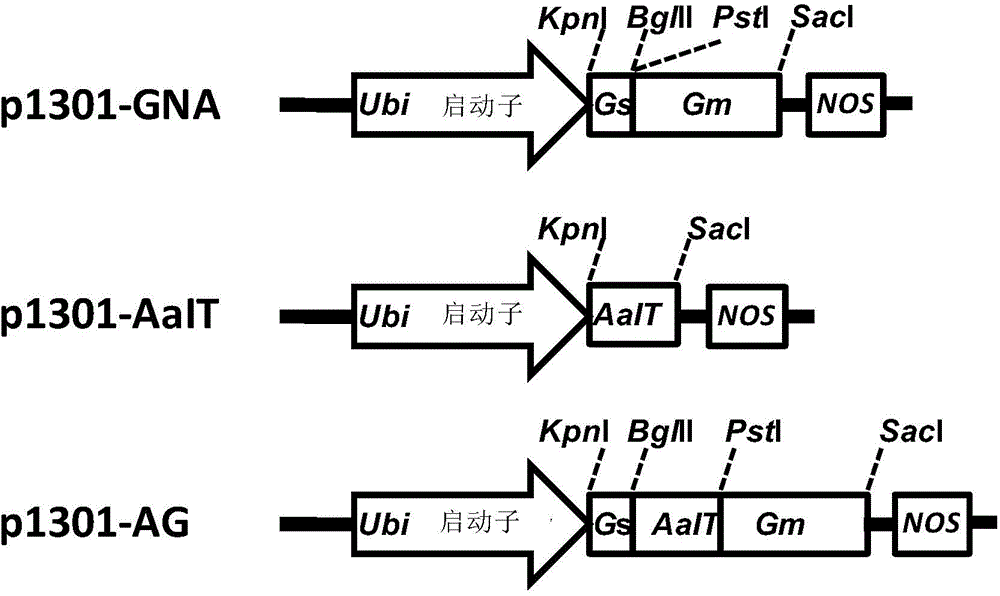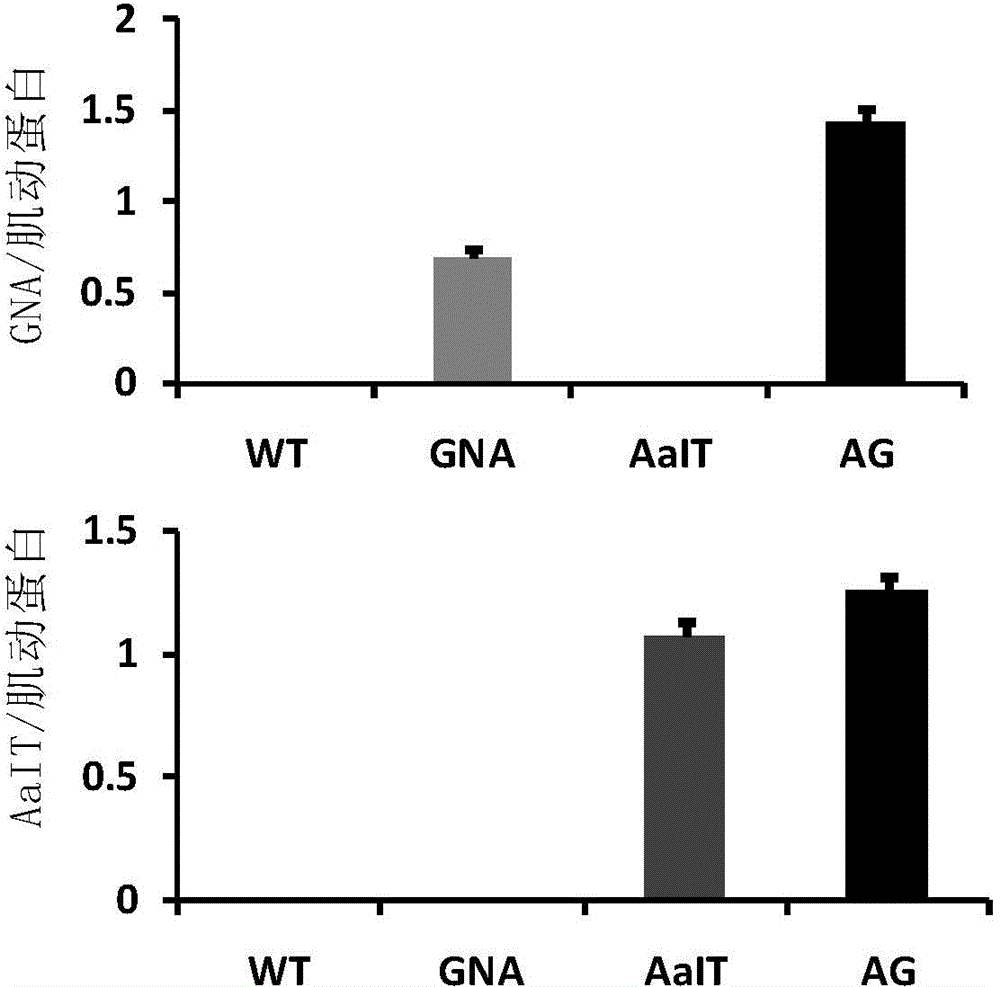Fusion protein for improving insect resistance of plants and application thereof
A fusion protein, plant lectin technology, applied in the field of new recombinant anti-insect fusion protein and its preparation method and use, the field of genetic engineering technology platform for anti-insect fusion protein, can solve the problem of not developing a satisfactory anti-insect protein, etc. question
- Summary
- Abstract
- Description
- Claims
- Application Information
AI Technical Summary
Problems solved by technology
Method used
Image
Examples
Embodiment 1
[0149] Example 1 Construction of p1301GNA, p1301AaIT and p1301AaIT / GNA (pAG) vectors
[0150] 1. Construction of p1301GNA
[0151] The intermediate vector pBluKSM-GNA was synthesized by Jerry Biological Company, including Kpn I and Sac I restriction sites. The GNA fragment was excised with Kpn I and Sac I restriction sites and connected to the vector pCAMBIA1301 to obtain p1301GNA. Gs is the signal peptide of GNA, and Gm is the mature peptide of GNA.
[0152] 2. Build p1301AaIT
[0153] The intermediate vector pBluKSM-AaIT was purchased from Jerry Biological Company, which contains two enzyme cutting sites, Kpn I and Sac I. The AaIT fragment was excised with Kpn I and Sac I restriction sites and then ligated into the vector pCAMBIA1301. The AaIT fragment was excised with Kpn I and Sac I restriction sites and connected to the vector pCAMBIA1301 to obtain p1301AaIT.
[0154] 3. Construction of p1301AaIT / GNA(pAG)
[0155] The full-length AaIT cDNA was amplified by PCR metho...
Embodiment 2
[0160] Example 2 Utilize p1301GNA, p1301AaIT and p1301AaIT / GNA (pAG) vectors to construct experimental plants
[0161] Using the plant transformation method in the general method of the present invention, the p1301GNA and p1301AaIT vectors prepared in Example 1 were transferred into Agrobacterium tumefaciens strain EHA105, and respectively transformed into tobacco, Arabidopsis and rice to obtain transgenic tobacco, Arabidopsis and rice. The obtained GNA gene transgenic plants and AaIT transgenic plants of the three crops were used as control plants in subsequent examples.
[0162] Using the plant transformation method in the general method of the present invention, the p1301AaIT / GNA (pAG) vector is transferred into the Agrobacterium tumefaciens strain EHA105, and respectively transformed into tobacco, Arabidopsis and rice to obtain the AG transgenic tobacco to be tested , transgenic Arabidopsis, transgenic rice.
[0163] The above-mentioned transgenic plants were detected, a...
Embodiment 3
[0167] The biological test of embodiment 3 cotton bollworm to transgenic tobacco
[0168] Get 30 3rd instar cotton bollworms with the same growth status, put them into the cages of the transgenic tobacco made in the above-mentioned embodiment 2 and three groups of contrast tobaccos (wild type, GNA, AaIT) respectively, and observe the growth of tobacco after 1 week . Experimental results such as Figure 8 It was shown that after 7 days after the 3rd instar cotton bollworm was released into the experimental plants, the damage of the transgenic plant AG was significantly smaller than that of other experimental types, and the resistance of the AG-transformed tobacco to the cotton bollworm was significantly improved.
[0169] Get 10 3rd instar cotton bollworms with consistent growth status and put them into the petri dish of the transgenic tobacco leaves and contrast tobacco (wild type, GNA, AaIT) leaves obtained through the above-mentioned embodiment 2, and observe the tobacco le...
PUM
 Login to View More
Login to View More Abstract
Description
Claims
Application Information
 Login to View More
Login to View More - R&D
- Intellectual Property
- Life Sciences
- Materials
- Tech Scout
- Unparalleled Data Quality
- Higher Quality Content
- 60% Fewer Hallucinations
Browse by: Latest US Patents, China's latest patents, Technical Efficacy Thesaurus, Application Domain, Technology Topic, Popular Technical Reports.
© 2025 PatSnap. All rights reserved.Legal|Privacy policy|Modern Slavery Act Transparency Statement|Sitemap|About US| Contact US: help@patsnap.com



